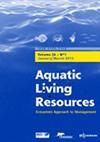Reproduction patterns of the bloody cockle Senilia senilis (Linnaeus 1758) in the Sine-Saloum inverse estuary
IF 1.9
4区 农林科学
Q3 FISHERIES
引用次数: 0
Abstract
Understanding the reproductive biology of a species is an important means of determining the renewal capacity of natural stocks, especially in the case of heavily exploited species. It is a fundamental element in supporting the implementation of management measures. Here, we studied the bloody cockle (S. senilis) in the Sine-Saloum, with the aim of describing its seasonal and spatial reproductive cycle. S. senilis reproduction was studied over an annual cycle at two sites chosen for their contrasting situations along the upstream-downstream gradient. The reproductive cycle was studied by histological analysis of a pool of individuals maintained in-situ and sampled throughout the year. Our results showed that gamete maturation is asynchronous within and between individuals. Gametogenesis mostly occurred in October. The maturation stage showed a seasonal pattern with continuous reproduction throughout the year, with two preferred periods between May and July and December and February. The reproductive cycle is highly dependent on temperature and salinity variations, resulting in a seasonal cycle and spatial heterogeneity. The temperature induces gametogenesis and salinity synchronizes the spawning periods.
Sine-Saloum逆河口血蛤的繁殖模式
了解一个物种的生殖生物学是确定自然种群更新能力的重要手段,特别是在被大量开发的物种的情况下。它是支持执行管理措施的基本要素。本文研究了Sine-Saloum的血蛤(S. senilis),目的是描述其季节和空间繁殖周期。根据上游和下游梯度的不同情况,选择了两个地点,以年为周期研究了老年沙蚕的繁殖。通过对全年保持在原位取样的个体池进行组织学分析,研究了繁殖周期。我们的研究结果表明,配子成熟在个体内部和个体之间是异步的。配子发生主要发生在10月。成熟期呈季节性,全年连续繁殖,有5 - 7月和12 - 2月两个优先期。繁殖周期高度依赖于温度和盐度的变化,造成季节周期和空间异质性。温度诱导配子体发生,盐度同步产卵期。
本文章由计算机程序翻译,如有差异,请以英文原文为准。
求助全文
约1分钟内获得全文
求助全文
来源期刊

Aquatic Living Resources
农林科学-海洋与淡水生物学
CiteScore
2.30
自引率
0.00%
发文量
10
审稿时长
>24 weeks
期刊介绍:
Aquatic Living Resources publishes original research papers, review articles and propective notes dealing with all exploited (i.e. fished or farmed) living resources in marine, brackish and freshwater environments.
Priority is given to ecosystem-based approaches to the study of fishery and aquaculture social-ecological systems, including biological, ecological, economic and social dimensions.
Research on the development of interdisciplinary methods and tools which can usefully support the design, implementation and evaluation of alternative management strategies for fisheries and/or aquaculture systems at different scales is particularly welcome by the journal. This includes the exploration of scenarios and strategies for the conservation of aquatic biodiversity and research relating to the development of integrated assessment approaches aimed at ensuring sustainable and high quality uses of aquatic living resources.
 求助内容:
求助内容: 应助结果提醒方式:
应助结果提醒方式:


